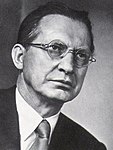| ||||||||||||||||||||||
All 31 Lombard seats to the Italian Senate | ||||||||||||||||||||||
|---|---|---|---|---|---|---|---|---|---|---|---|---|---|---|---|---|---|---|---|---|---|---|
| ||||||||||||||||||||||
Lombardy elected its first delegation to the Italian Senate on April 18, 1948. This election was a part of national Italian general election of 1948 even if, according to the newly established Italian Constitution, every senatorial challenge in each Region is a single and independent race.
The election was won by the centrist Christian Democracy, as it happened at national level. Pavia and Mantua were the sole provinces to oppose this result, giving a plurality to the Social-Communist alliance.
Background
Alcide De Gasperi's Christian Democracy had obtained very good results during quite all municipal elections in Lombardy in 1946. However, their Soviet-aligned opponents looked at this region as one of their possible zones of success, considering the local strength of the Socialist Party before the Fascist era.
Even if the Front obtained some seats in the agricultural south, De Gasperi obtained an absolute majority at regional level, with some exceptional peaks in the alpine north: Lombardy became the region with the highest number of constituencies where the landslide clausola was satisfied. The centre-left alliance between the Italian Democratic Socialist Party and the Italian Republican Party obtained some seats in Milan, a city led by Democratic Socialist mayor Antonio Greppi.
Electoral system
The electoral system introduced in 1948 for the newly elected Senate was a strange hybrid which established a form of proportional representation into FPTP-like constituencies. A candidate needed a landslide victory of more than 65% of votes to obtain a direct mandate. All constituencies where this result was not reached entered into an at-large calculation based upon the D'Hondt method to distribute the seats between the parties, and candidates with the best percentages of suffrages inside their party list were elected.
Results
| Party | votes | votes (%) | seats |
|---|---|---|---|
| Christian Democracy | 1,854,032 | 53.8 | 18 |
| Popular Democratic Front | 1,164,769 | 33.8 | 10 |
| Socialist Unity+Italian Republican Party | 364,642 | 10.8 | 3 |
| Others | 64,284 | 1.9 | - |
| Total parties | 3,447,727 | 100.0 | 31 |
Sources: Italian Ministry of the Interior
Constituencies
- Senators with a direct mandate have bold percentages. Please remember that the electoral system was, in the other cases, a form of proportional representation and not a FPTP race: so candidates winning with a simple plurality could have (and usually had) a candidate (always a Christian democrat) with more votes in their constituency.
Substitutions
- Amilcare Locatelli for Rho (36.2%) replaced Pietro Torelli in 1948. Reason: death.
- Edoardo Origlia for Milan 2 (54.5%) replaced Antonio Bareggi in 1950. Reason: death.
- Gianmaria Cornaggia for Lodi (47.7%) replaced Carlo Perini in 1952. Reason: death.
Notes
- Italian Ministry of Interior
| Regional elections | |
|---|---|
| General elections | |
| Senate elections | |
| European Parliament elections | |
| Referendums | |

